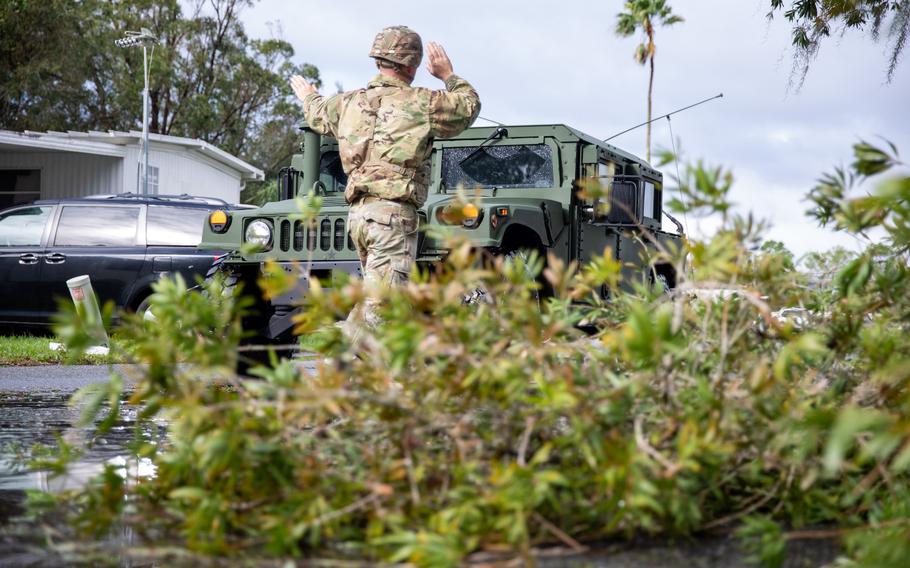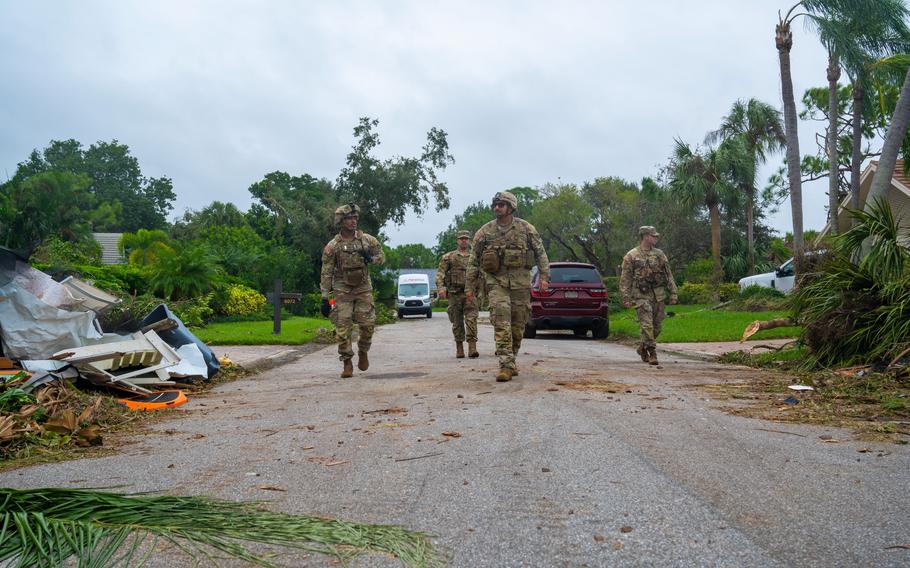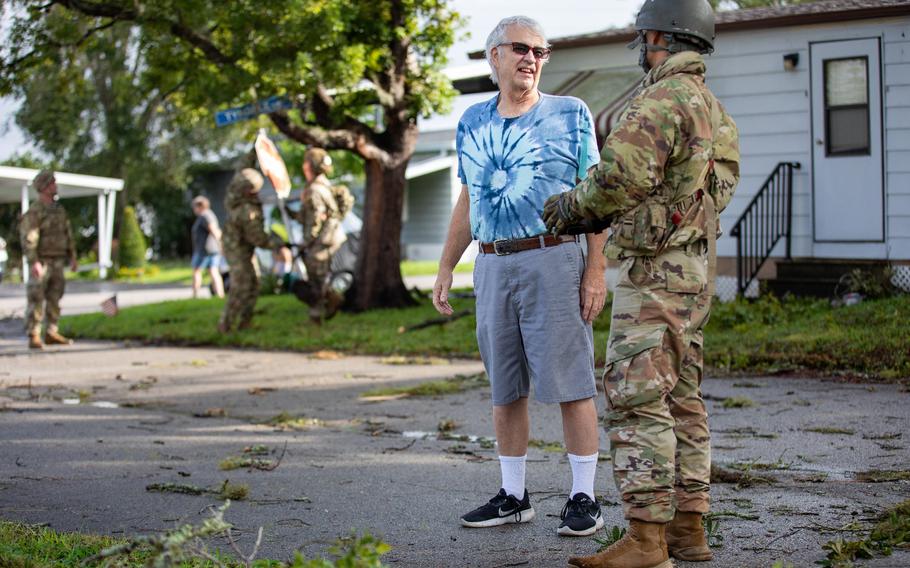
Florida National Guard soldiers with the 3rd Battalion, 116th Field Artillery Regiment, conduct a survey and assist patrol following Hurricane Milton in Kissimmee, Fla., on Oct. 10, 2024. (Marc Morgenstern/U.S. Army)
The National Guard plans to flow up to 1,500 additional troops into Florida during the coming days as it responds to Hurricane Milton, the second major hurricane to strike the state in two weeks, military officials said Friday.
The Guard’s response in the state is expected to grow from about 6,500 troops to some 8,000 Guardsmen by this weekend, said Maj. Gen. Win Burkett, the National Guard Bureau’s domestic operations and force development director. Troops from Florida and 19 other states have been working around the clock to rescue survivors, clear paths and deliver aid to those impacted by the Category 3 storm that struck near Sarasota late Wednesday, officials said.
Guard forces were credited with aiding in the rescue of more than 330 people and 39 pets by Friday afternoon, state officials said. Guard troops in the state had also cleared some 1,300 miles of routes and about 249 cubic yards of debris since the storm moved off Florida’s coast Thursday.

Soldiers from the Florida and South Carolina National Guards search for residents in need of assistance near Stuart, Fla., on Oct. 10, 2024. Areas of the city were decimated by tornadoes spawned by Hurricane Milton as the storm progressed across the state. (Tech. Sgt. Chelsea Smith/U.S. Air National Guard photo)
The Guard is using 31 aircraft and more than 500 high-wheeled vehicles to reach stranded individuals and help clear debris, said Army Col. Blake Heidelberg, the director of military support for the Florida National Guard. Guard troops have established 30 distribution points throughout the impacted areas to provide food and other supplies in the wake of the storm that spawned more than a dozen tornadoes, caused flooding, and knocked out power to at least 3 million people, authorities said. The storm had been blamed for at least 14 deaths as of Friday, according to NBC News.
Heidelberg said the Florida Guard was as prepared as possible for Hurricane Milton, which saw state officials activate the entire force and bring in dozens of soldiers and airmen from other states’ National Guards to preset and respond quickly once the storm passed. The Florida Guard already had several thousand troops activated for post-storm response from Hurricane Helene, which struck northwest Florida as a Category 4 storm on Sept. 26.
The Pentagon had prepared to flow active-duty troops into Florida to help in the response to Milton, but Heidelberg said Friday that the regular Army troops — including dozens from Fort Stewart in southeast Georgia — were not needed after Milton struck slightly south of initial projections, which had warned the storm could have directly hit the populous Tampa area as a Category 5 hurricane.
“We have no further unmet needs,” Heidelberg told reporters Friday. “Fortunately, with the storm taking a little bit of a shift to the south and not being that Category 5 that we all feared, we didn’t need that external support from” from the active-duty military.

Florida National Guard soldiers with the 3rd Battalion, 116th Field Artillery Regiment, check in with a resident and clear debris following Hurricane Milton during a survey and assist patrol in Kissimmee, Fla., on Oct. 10, 2024. (Marc Morgenstern/U.S. Army photo)
Active-duty troops remain on the ground in mountainous western North Carolina, where they have worked with Guard forces to rescue victims of Hurricane Helene stranded in isolated homes and communities for more than a week. While roughly 1,500 active-duty soldiers from Fort Liberty, N.C., and Fort Campbell, Ky., have spearheaded rescue and supply efforts in the areas devastated by flooding and landslides from Helene, some 4,500 Guard troops from more than a dozen states have continued to work in other areas ravaged by that storm, Burkett said.
The Guard has slowly pulled some troops from post-Helene operations, but Burkett said he expected the Guard to continue life-saving efforts — especially in North Carolina — for some time. That’s especially true, he said, for National Guard helicopter units that have been using hoist capabilities to rescue people and their pets.
“In this case, based on the amount of damage in that area that occurred in North Carolina, it’s very difficult to get a really good assessment of that damage,” the general told reporters Friday. “So, I suspect it will continue until the ground routes are completely open, and you can get to some of these hard-to-reach areas by ground.”
Guard forces had assisted in the rescue of at least 750 people in North Carolina, including 219 helicopter hoist operations, Burkett said.
The back-to-back storms have taken a toll on the National Guard, Burkett and Heidelberg admitted. That’s especially true in Florida where multiple storms during hurricane season are becoming the norm.
“It’s a strain on our soldiers and our airmen … but when they’re out there helping our citizens, it kind of recharges that battery, and they understand and they appreciate why they’re wearing the uniform,” Heidelberg said. “After this many storms, we’re tired, I’m not going to lie, we’re worn down, and we would like a break. But [we’re still] able to respond and stay motivated.”
As the Guard worked to clear routes and clean up across the Florida peninsula, major military bases on Friday were doing their own cleanups and damage assessments. Navy officials said Naval Air Station Jacksonville and nearby Naval Station Mayport had reopened most facilities by Friday after sustaining minimal damage from Milton.
Patrick Space Force Base, near Cape Canaveral, too, had announced it would reopen Friday afternoon sustaining only minor damage.
Meanwhile, MacDill Air Force Base remained closed indefinitely on Friday as teams continue work to clear the base of debris. The Tampa-area base — home to the 6th Air Refueling Wing, U.S. Central Command and U.S. Special Operations Command — suffered from many downed trees and flooding in low-lying areas, said Rose Riley, an Air Force spokeswoman. She said several roads on the installation remained impassable on Friday.